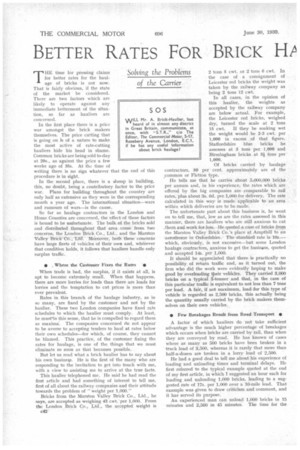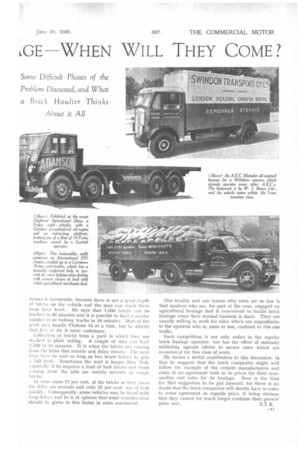BETTER RATES FOR BRICK HP LGE WHEN WILL THEY COME?
Page 84

Page 85

If you've noticed an error in this article please click here to report it so we can fix it.
Solving the Problems of the Carrier THE time for pressing claims for better rates for the haulage of bricks is not now. That is fairly obvious, if the state
,-of the market be considered. There are two factors which are likely to operate against any immediate betterment of the situation, so far as hauliers are concerned.
In the first place there is a price war amongst the brick makers themselves. The price cutting that is going on is of a nature to make the most active of rate-cutting hauliers hide his head in shame. Common bricks are being sold to-day at 20s., as against the price a few weeks ago of 35s. At thii time of writing there is no sign whatever that procedure is in sight. the end of this In the second place, there is a slump in building, this, no doubt, being a contributory factor to the price war. Plans for building throughout the country are only half as extensive as they were in the corresponding month a year ago. The international situation—wars and rumours of wars—is the cause.
So far as haulage contractors in the London and Home Counties are concerned, the effect of these factors is bound to be unfortunate. The bulk of the bricks sold and distributed throughout that area come limn two concerns, the London Brick Co., Ltd., and the Marston Valley Brick Co., Ltd'. Moreover, both these concerns have large fleets of vehicles of their own and, wheiever that condition holds, it follows that hauliers handle only surplus traffic.
• , Where the Customer Fixes the Rates •
When trade is bad, the surplus, if it exists at all, is apt to become extremely small. When that happens, there are more lorries for loads than there are loads for lorries and the temptation to cut prices is more than ever prevalent.
Rates in this branch of the haulage industry, as in so many, are fixed by the customer and not by the haulier. These two London companies have fixed rate schedules to which the haulier must comply. At least, he musein this sense, that he is compelled to regard them as maxima'. The companies concerned do not appear to be averse to accepting tenders to haul at rates below their own schedules—for which, of course, they cannot be blamed. This practice, of the customer fixing the rates for haulage, is one of the things that we must eliminate so soon as that becomes possible.
But let us read what a brick haulier has to say about his own busineqs. He is the first of the many who are responding to the invitation to get into touch with me, with a view to assisting me to arrive at the true facts.
This haulier telephoned me. He said he had read the first article and had something of interest to tell me, first of all about the railway companies and their attitude towards the problem of " weight per 1,000."
Bricks from the Marston Valley Brick Co., Ltd., he says, are accepted as weighing 43 cwt. per 1,000. From the London Brick Co., Ltd., the accepted weight is c42 2 tons 5 cwt. or 2 tons 6 cwt. In the case of a consignment of Leicester red bricks the weight was taken by the railway company as being 2 tons 12 cwt.
In all cases, in the opinion of this haulier, the weights as accepted by the railway company are below actual. For example, the Leicester red bricks, weighed dry, turned the scale at 2 tons 15 cwt. If they be soaking wet the weight would be 2-3 cwt. per 1,000 in excess of that figure. Staffordshire blue bricks he assesses at 3 tons per 1,000 and Birmingham bricks at 31. tons per 1,000.
Of bricks carried by haulage contractors, 80 per cent. approximately are of the common or Fletton type.
He tells me that he carries about 5,000,000 bricks per annum and, in his experience, the rates which are offered by the big companies are comparable to rail rates, plus about 3s. 6d. per 1,000 for delivery. The rate calculated in this way is made applicable to an area within which deliveries are to be made.
The unfortunate part about this business is, he went on to tell me, that, low as are the rates assessed in this manner, there are hauliers who are still anxious to cut ,them and work for less. He quoted a case of bricks from the Marston Valley Brick Co.'s place at Ampthill to an • aerodrome in Oxfordshire. The standard rate is 165.— which, obviously, is not excessive—but some London haulage contractors, anxious to get the busintss, quoted and accepted 14s. per 1,000.
It should be appreciated that there is practically no possibility of return traffic and, as it turned out, the firm who did the work were evidently hoping to make good by overloading their vehicles. They carried 3,000 bricks on a typical 3-tonner and that, in the case of this particular traffic is equivalent to not less than 7 tons per load. A fair, if not maximum, load for this type of vehicle is regarded as 2,500 bricks, this actually being the quantity usually carried by the brick makers themselves on their own vehicles.
• Few Breakages Result from Road Transport •
A factor of which hauliers do not take sufficient advantage is the much higher percentage of breakages which occurs when bricks are carried by rail, than when they are conveyed by road. He has known of cases where as many as 500 bricks have been broken in a truck load of 3,500, whereas it is rarely that more than half-a-dozen are broken in a lorry load of 2,500.
He had a good deal to tell me about his experience of loading and unloading times and terminal delays. He first referred to the typical example quoted at the end of my first article, in which I suggested an hour each for loading and unloading 1,000 bricks, leading to a suggested rate of 17s. per 1,000 over a 10-mile lead. That example was given to draw criticism and comment, and it has served its purpose.
An experienced man can unload 1,000 bricks in 15 minutes and 2,500 in 45 minutes. The time for the
former is favourable, because there is not a great depth of bricks on the vehicle and the man can reach them from hoer level. He says that 1,000 bricks can be stacked in 30 minutes and it is possible to load a similar number from railway trucks in 10 minutes. Most of the good men handle Flettons 14 at a time, but he admits that five or six is more customary.
Collection of bricks from a yard in which they are stacked is plain sailing. A couple of men can load 2,500 in 30 minutes. It is when the bricks are coming from the kilns that trouble and delay ensues. The man may have to wait so long as two hours before he gets a full load. Sometimes the wait is longer than that, especially if he requires kb:lad of best bricks and those coming from the kiln are mainly seconds or rough bricks.
In some cases 75 per cent. of the bricks as they leave the kilns are seconds and only 25 per cent, are of best quality. Consequently, some vehicles may be faced with long delays and he is of opinion that some consideration should be given to this factor in rates assessment.
One trouble and one reason why rates are so low is that hauliers who are, for part of the year, engaged on agricultural haulage find it convenient to tackle brick haulage when their normal business is slack. They are usually willing to work for rates Which are unprofitable to the operator who is, more or less, confined to this one traffic.
Such competition is not only unfair to the regular brick haulage operator, but has the effect of seriously militating against efforts to secure rates which are economical for this class of work_
He makes a useful contribution to this discussion, in that he suggests that the brick companies might well follow the example of the cement manufacturers and come to an agreement both as to prices for their commodity and rates for its haulage. Now is the time for that suggestion to be put forward, for there is no doubt that the brick companies will shortly have to comP to some agreement as regards price, it being obvious that they cannot for much longer continue their present
price war. S.T.R.




































































































































